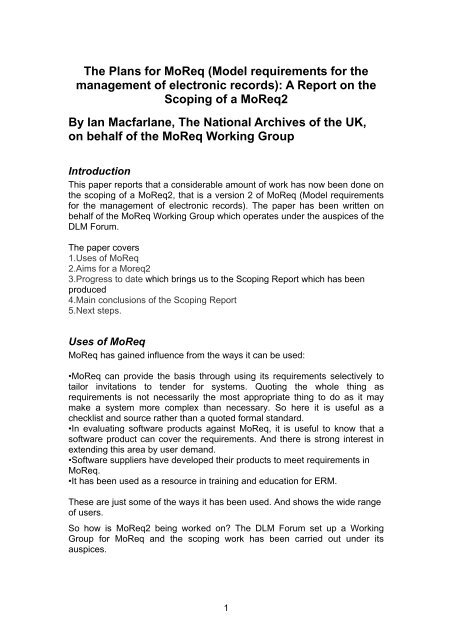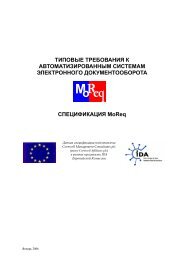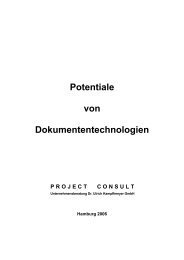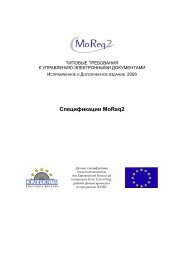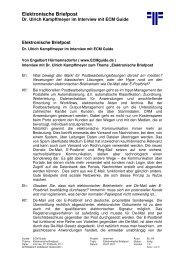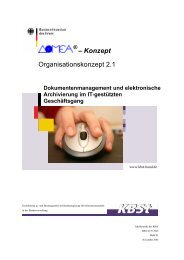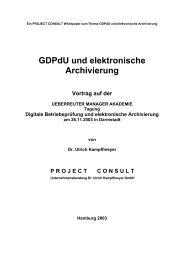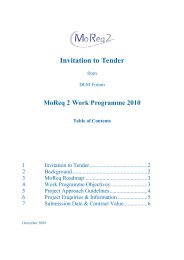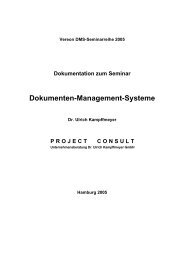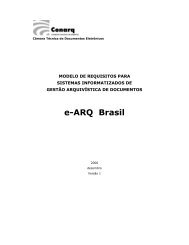The Plans for MoReq (Model requirements for the ... - DLM Forum
The Plans for MoReq (Model requirements for the ... - DLM Forum
The Plans for MoReq (Model requirements for the ... - DLM Forum
You also want an ePaper? Increase the reach of your titles
YUMPU automatically turns print PDFs into web optimized ePapers that Google loves.
<strong>The</strong> <strong>Plans</strong> <strong>for</strong> <strong>MoReq</strong> (<strong>Model</strong> <strong>requirements</strong> <strong>for</strong> <strong>the</strong><br />
management of electronic records): A Report on <strong>the</strong><br />
Scoping of a <strong>MoReq</strong>2<br />
By Ian Macfarlane, <strong>The</strong> National Archives of <strong>the</strong> UK,<br />
on behalf of <strong>the</strong> <strong>MoReq</strong> Working Group<br />
Introduction<br />
This paper reports that a considerable amount of work has now been done on<br />
<strong>the</strong> scoping of a <strong>MoReq</strong>2, that is a version 2 of <strong>MoReq</strong> (<strong>Model</strong> <strong>requirements</strong><br />
<strong>for</strong> <strong>the</strong> management of electronic records). <strong>The</strong> paper has been written on<br />
behalf of <strong>the</strong> <strong>MoReq</strong> Working Group which operates under <strong>the</strong> auspices of <strong>the</strong><br />
<strong>DLM</strong> <strong>Forum</strong>.<br />
<strong>The</strong> paper covers<br />
1.Uses of <strong>MoReq</strong><br />
2.Aims <strong>for</strong> a Moreq2<br />
3.Progress to date which brings us to <strong>the</strong> Scoping Report which has been<br />
produced<br />
4.Main conclusions of <strong>the</strong> Scoping Report<br />
5.Next steps.<br />
Uses of <strong>MoReq</strong><br />
<strong>MoReq</strong> has gained influence from <strong>the</strong> ways it can be used:<br />
•<strong>MoReq</strong> can provide <strong>the</strong> basis through using its <strong>requirements</strong> selectively to<br />
tailor invitations to tender <strong>for</strong> systems. Quoting <strong>the</strong> whole thing as<br />
<strong>requirements</strong> is not necessarily <strong>the</strong> most appropriate thing to do as it may<br />
make a system more complex than necessary. So here it is useful as a<br />
checklist and source ra<strong>the</strong>r than a quoted <strong>for</strong>mal standard.<br />
•In evaluating software products against <strong>MoReq</strong>, it is useful to know that a<br />
software product can cover <strong>the</strong> <strong>requirements</strong>. And <strong>the</strong>re is strong interest in<br />
extending this area by user demand.<br />
•Software suppliers have developed <strong>the</strong>ir products to meet <strong>requirements</strong> in<br />
<strong>MoReq</strong>.<br />
•It has been used as a resource in training and education <strong>for</strong> ERM.<br />
<strong>The</strong>se are just some of <strong>the</strong> ways it has been used. And shows <strong>the</strong> wide range<br />
of users.<br />
So how is <strong>MoReq</strong>2 being worked on? <strong>The</strong> <strong>DLM</strong> <strong>Forum</strong> set up a Working<br />
Group <strong>for</strong> <strong>MoReq</strong> and <strong>the</strong> scoping work has been carried out under its<br />
auspices.<br />
1
Aims <strong>for</strong> a <strong>MoReq</strong>2<br />
<strong>The</strong> proposed new version of <strong>MoReq</strong> has been named <strong>MoReq</strong>2. It is intended<br />
to extend <strong>the</strong> functional <strong>requirements</strong> and also to extend into testing software<br />
products compliance against <strong>the</strong> <strong>requirements</strong>. A large number of <strong>the</strong> Working<br />
Group members, and <strong>the</strong> comments which were received more widely, called<br />
<strong>for</strong> compliance testing.<br />
In a wider sense it will aim to support activities in every country of <strong>the</strong> EU to<br />
improve <strong>the</strong> completeness and quality of electronic records.<br />
Why is <strong>MoReq</strong>2 needed? It is needed to update existing areas of <strong>the</strong><br />
<strong>requirements</strong> by enhancing <strong>the</strong>m to meet <strong>the</strong> latest best practice. It will also<br />
add areas which have become important in <strong>the</strong> intervening four years.<br />
<strong>MoReq</strong> has no tools <strong>for</strong> compliance testing. <strong>The</strong>se need to be developed.<br />
<strong>The</strong> <strong>requirements</strong> need <strong>the</strong> flexibility to be capable of being implemented in<br />
<strong>the</strong> many different environments with different legislation and records<br />
management cultures. <strong>The</strong> scoping of <strong>MoReq</strong>2 defines it in modules to enable<br />
this.<br />
To maintain <strong>the</strong> standing and level of use of <strong>MoReq</strong> in <strong>the</strong> fast moving field of<br />
electronic records management, it has to be up to date with new standards<br />
and best practice.<br />
Is a <strong>MoReq</strong>2 achievable? <strong>The</strong>re are several reasons to believe that it is:<br />
•<strong>The</strong> model <strong>requirements</strong> are intended to be flexible and can be tailored to<br />
different environments. <strong>The</strong>y do not constitute a standard IT system ~ that<br />
could not be done to everyone’s agreement.<br />
•<strong>MoReq</strong>2 will be building on <strong>the</strong> fact of wide agreement and adoption of <strong>the</strong><br />
original <strong>MoReq</strong>.<br />
•In scope, it is to be an evolutionary update to <strong>the</strong> original <strong>MoReq</strong>, not a<br />
radically different product. <strong>MoReq</strong> 2 is not intended to shift its focus from<br />
mainstream management of electronic records to a new area, such as<br />
specialist management of archives.<br />
•In extending <strong>the</strong> scope to compliance testing, it is known that <strong>the</strong> concept has<br />
been proved already in several countries.<br />
Progress<br />
What has happened so far on <strong>MoReq</strong>2? <strong>The</strong>re have been a number of steps<br />
completed:<br />
a) Working Group meetings in March and October 2004 laid <strong>the</strong> ground work<br />
b) <strong>The</strong>re was a good response to a wide call <strong>for</strong> comments ~ 170 comments<br />
from 18 countries<br />
c) Scoping work was done and was circulated to <strong>the</strong> WG at two stages to<br />
produce a Scoping Report<br />
d) <strong>The</strong> Scoping Report has undergone initial discussion with <strong>the</strong> European<br />
Commission.<br />
2
Main Conclusions of <strong>the</strong> Scoping Report <strong>for</strong> <strong>MoReq</strong>2<br />
So what will <strong>MoReq</strong>2 consist of? To meet <strong>the</strong> aims:<br />
•<strong>The</strong> <strong>requirements</strong> are to be arranged in modules. And <strong>the</strong>re is a so called<br />
base module because it constitutes <strong>the</strong> minimum necessary to provide<br />
credible electronic records management.<br />
Key Issue: Base Module<br />
___________________________<br />
• <strong>The</strong> base module constitutes <strong>the</strong> minimum<br />
necessary to provide credible electronic<br />
records management<br />
• Important areas <strong>for</strong> enhancement are:<br />
– Controls on access to facilities<br />
– Retention schedules and disposal<br />
– Export and transfer<br />
– Preservation<br />
– Metadata<br />
6 October 2005 EU <strong>DLM</strong> <strong>Forum</strong> Conference Budapest 8<br />
•Important areas in <strong>the</strong> base module have been identified <strong>for</strong> enhancement<br />
and <strong>the</strong>se include:<br />
-Controls on access to facilities ~ more options and flexibility are intended<br />
here. Providing <strong>the</strong> ability to have many roles defined ~ Allowing use of<br />
facilities by roles such as Corporate records manager, local records coordinator,<br />
registry official, records reviewer. Also controls are needed on<br />
access to parts of <strong>the</strong> business classification scheme <strong>for</strong> those roles and <strong>for</strong><br />
various types of users.<br />
-Enhancement of retention schedules and disposal to cover <strong>the</strong>m more<br />
thoroughly.<br />
-Export and transfer in generic terms. I will come back to taking <strong>the</strong>se <strong>for</strong>ward<br />
more fully.<br />
-Enhancement of digital preservation to treat it more thoroughly.<br />
-For Metadata, elements <strong>for</strong> preservation will be included. It will be ensured<br />
that <strong>the</strong> metadata is compatible with ISO 23081 (Principles <strong>for</strong> metadata) and<br />
with <strong>the</strong> OAIS (Open Archival In<strong>for</strong>mation System standard ISO 14721)<br />
-Importantly <strong>the</strong> metadata section is interwoven into <strong>the</strong> <strong>requirements</strong>. It is not<br />
merely a passive requirement that has to be supported in ERM systems. It<br />
3
<strong>for</strong>ces functionality to be developed which consistently en<strong>for</strong>ces <strong>the</strong> metadata<br />
<strong>requirements</strong>. <strong>MoReq</strong> has some metadata specified but <strong>the</strong>re needs to be<br />
more.<br />
However electronic records management alone is not enough. <strong>The</strong> problem is<br />
that various systems create and hold in<strong>for</strong>mation that should be captured as<br />
records. <strong>The</strong>y need to be integrated to manage in<strong>for</strong>mation and avoid losing<br />
records.<br />
Key Issue: Integrated In<strong>for</strong>mation<br />
Architecture<br />
Content<br />
manage<br />
ment<br />
Document<br />
management<br />
e-records<br />
manage-<br />
ment<br />
Workflow,<br />
casework<br />
Knowledge<br />
bases<br />
Transaction<br />
databases<br />
6 October 2005 EU <strong>DLM</strong> <strong>Forum</strong> Conference Budapest 9<br />
Integration with o<strong>the</strong>r applications in this way is defined in <strong>MoReq</strong>2 optional<br />
modules which may or may not be needed according to <strong>the</strong> environment in<br />
which electronic records management is being implemented.<br />
<strong>The</strong>se optional modules include:<br />
•Integration with Content Management Systems; “Content management <strong>for</strong><br />
<strong>the</strong>se purposes means <strong>the</strong> management of documents and records in a<br />
variety of contexts. Including importantly internet protocol based environment<br />
and browsers. <strong>The</strong> main challenge is <strong>the</strong> need <strong>for</strong> robust control of public<br />
website, intranet and extranet content. It will be possible to take this to several<br />
levels: Simple content management is where <strong>the</strong>re is a capability to publish<br />
a single document or object from <strong>the</strong> ERM environment to a website; Web<br />
content management is where complex compound objects from various<br />
sources are published to websites: Enterprise content management is where<br />
<strong>the</strong> previous environments have all been integrated with <strong>the</strong> ERM system;<br />
4
•Management of non-electronic records (that is physical records) and hybrid<br />
files (combinations of electronic and physical records) will be enhanced;<br />
•Workflow (existing) and Case work will be added;<br />
•Document management and collaborative working will be enhanced;<br />
•Likewise encryption, watermarking, electronic signatures;<br />
•And likewise interoperability and openness;<br />
•Distributed systems which is a new module but including existing<br />
<strong>requirements</strong> drawn from <strong>the</strong> base module and o<strong>the</strong>r sections.<br />
<strong>The</strong> key issue of flexibility is addressed in several ways:<br />
•Enhancements to <strong>the</strong> base module<br />
•<strong>The</strong>se optional modules<br />
•And through “Chapter 0”s.<br />
<strong>The</strong>re is a consensus in <strong>the</strong> Working Group that a country introduction or<br />
“Chapter 0” should be written by <strong>the</strong> <strong>DLM</strong> <strong>Forum</strong> representatives of each<br />
country. <strong>The</strong>se would be provided <strong>for</strong> inclusion at <strong>the</strong> finalisation of <strong>the</strong><br />
various language versions of <strong>MoReq</strong>2. This was done by some translators of<br />
<strong>the</strong> original <strong>MoReq</strong> to explain <strong>the</strong> concept of “records” and <strong>the</strong>ir context in<br />
some cultures (<strong>for</strong> example Slovenian and Portuguese translations).<br />
<strong>The</strong> country should decide what will be appropriate in <strong>the</strong>ir country<br />
introduction and it is likely to include:<br />
· <strong>the</strong> effect of national legislation<br />
· <strong>the</strong> effect of <strong>the</strong> records management culture; <strong>for</strong> example procedures<br />
around <strong>MoReq</strong>2 <strong>for</strong> rules and processes <strong>for</strong> recording documentary<br />
transactions, providing registry facilities using <strong>MoReq</strong>2 functions etc<br />
· translation in<strong>for</strong>mation particularly on <strong>the</strong> key concepts such as <strong>the</strong><br />
treatment of <strong>the</strong> words <strong>for</strong> documents and records.<br />
Compliance testing is envisaged to provide:<br />
- Evaluating software products against <strong>MoReq</strong>2 so that <strong>the</strong>y are known to be<br />
compliant<br />
- Also allowing software to be tested in particular systems by <strong>the</strong><br />
implementers.<br />
For this, standard test criteria and test scripts with expected results will be<br />
needed as part of <strong>MoReq</strong>2 to support consistent evaluation of compliance<br />
through testing.<br />
An overall compliance testing regime will be <strong>for</strong> <strong>the</strong> <strong>DLM</strong> <strong>Forum</strong> to devise on<br />
<strong>the</strong> basis of <strong>MoReq</strong>2.<br />
5
Key Issue: Facilitating Interoperability<br />
___________________________________________________________<br />
Import<br />
File Stores<br />
on on servers<br />
Document<br />
Management<br />
Applications<br />
Import<br />
Current<br />
Records<br />
Management<br />
Application<br />
Transfer<br />
New Records<br />
Management<br />
Application<br />
Export<br />
Archive<br />
6 October 2005 EU <strong>DLM</strong> <strong>Forum</strong> Conference Budapest 13<br />
<strong>The</strong>re will be development in generic terms <strong>for</strong> facilitating interoperability in<br />
<strong>the</strong> Base module.<br />
Fur<strong>the</strong>r development of export and transfer possibly in terms of XML schemas<br />
and compliance testing of <strong>the</strong>se aspects will be <strong>for</strong> <strong>the</strong> <strong>DLM</strong> <strong>Forum</strong> on <strong>the</strong><br />
basis of <strong>MoReq</strong>2.<br />
<strong>MoReq</strong>2 will take into account developments since 2001 from:<br />
• ISO15489 <strong>the</strong> over arching Records Management standard<br />
• <strong>The</strong> work in operation under <strong>the</strong> <strong>The</strong> National Archives of <strong>the</strong> UK’s TNA<br />
2002 <strong>requirements</strong><br />
• Likewise with <strong>the</strong> German Domea<br />
• And o<strong>the</strong>r national projects<br />
• Ensuring compatibility with key standards such as Metadata <strong>for</strong> records –<br />
Principles (standard ISO 23081) and with <strong>the</strong> OAIS standard (ISO 14721).<br />
Next Steps<br />
Firstly to recap on what progress has been achieved so far:<br />
• <strong>The</strong> <strong>DLM</strong> <strong>Forum</strong> Working Group meetings, scoping and review in 2004,<br />
2005<br />
• <strong>The</strong> scoping report is in final draft now<br />
• It has been under review by <strong>the</strong> European Commission in September.<br />
6
Targeted:<br />
Next Steps <strong>for</strong> <strong>MoReq</strong>2<br />
___________________________<br />
• Endorsement by <strong>DLM</strong> <strong>Forum</strong> in October<br />
• European Commission ITT; and project in<br />
partnership with <strong>DLM</strong> <strong>Forum</strong> in 2006<br />
• In parallel, <strong>DLM</strong> <strong>Forum</strong> progress<br />
compliance testing regime and export and<br />
transfer methods<br />
• Publication of <strong>MoReq</strong>2 in 2007 and start<br />
compliance testing<br />
6 October 2005 EU <strong>DLM</strong> <strong>Forum</strong> Conference Budapest 16<br />
<strong>The</strong> targets are now:<br />
• Endorsement by <strong>DLM</strong> <strong>Forum</strong> members at <strong>the</strong> Annual General Meeting.<br />
This is important to support <strong>the</strong> European Commission’s consideration of<br />
an ITT; and EC funded project in partnership with <strong>the</strong> <strong>DLM</strong> <strong>Forum</strong> in 2006<br />
• In parallel, <strong>the</strong> <strong>DLM</strong> <strong>Forum</strong> will progress on a compliance testing regime<br />
and on export and transfer methods<br />
• <strong>The</strong> overall targets are <strong>the</strong> publication of <strong>MoReq</strong>2 in 2007 and a start to<br />
compliance testing.<br />
As a post conference note, it can be reported that <strong>the</strong> <strong>DLM</strong> <strong>Forum</strong> Annual<br />
General Meeting on 6 th October 2005 endorsed <strong>the</strong> Scoping Report <strong>for</strong><br />
<strong>MoReq</strong>2. It is available at<br />
http://www.dlmnetwork.org/index.php?categoryid=8&p13_sectionid=1&p13_fileid=32<br />
7


